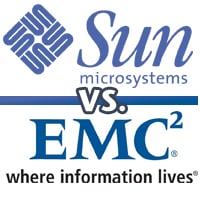Original URL: https://www.theregister.com/2008/06/05/emc_and_sun_ssd_strategies/
Battle of the SSD strategies: Sun vs. EMC
Living information takes on the dot in dot-com
Posted in Channel, 5th June 2008 23:18 GMT
How do the flash solid state disk (SDD) strategies of EMC and Sun differ?
EMC is super-charging its Symmetrix arrays with enterprise flash solid state drives (SSD). The idea is to have the most frequently accessed data reside in a tier zero of SSD storage with less frequently-accessed data in Fibre Channel hard disk drives (HDD). Accessing servers will link to Symmetrix as external storage and not 'see' the SSD tier as logically separate from any other storage tier in Symmetrix, it just being much faster storage still presented as drives in an array.
Sun's tack is different and it wants to use flash as a cache glue to bind storage and servers closer together. It appears that for Sun flash is a server direct-attached storage (DAS) medium and not an external-attach storage medium.
Sun is going to supercharge its servers and storage with SSD positioned as a cache between disk drives and a server's main memory. Sun people describe a storage hierarchy starting with registers and level 1 cache in processor cores, level 2 cache between the processor cores and main memory (DRAM) and, from now on, level 3 or 4 cache being flash SSD sitting between DRAM and hard drives.
The company sees flash supporting both read-intensive I/O and write-intensive I/O. On the read side the flash becomes a cheap extension to DRAM and enables a much larger working set for applications. Instead of having to page between main memory and disk as is common with virtual memory they can page between DRAM and flash. So applications run faster.
 On the write side the flash, because it is non-volatile, can be used to store transaction-type data that an app needs to know is written to non-volatile storage, committed, before it can move on to other work. This refers to system software, such as ZFS and databases, as well as to transaction-processing software. So applications run faster again.
On the write side the flash, because it is non-volatile, can be used to store transaction-type data that an app needs to know is written to non-volatile storage, committed, before it can move on to other work. This refers to system software, such as ZFS and databases, as well as to transaction-processing software. So applications run faster again.
Thus, for Sun, flash is being used to accelerate server software in an intrinsic way whereas for EMC it is going to be used to accelerate external storage array I/O generally.
Sun will refresh its server and hybrid server/storage hardware with flash. Sun blogger Taylor Allis writes: "we are introducing a new product line with multiple options that span storage and server systems."
Flash is a critical part of Sun's Open Storage plans with Open Storage being a combination on open source software and industry-standard hardware. Open Storage customers will be able to choose between hard disk drives (HDD) and solid state storage (SSD) or a hybrid combination with software products optimized to use SSD to store working data and so access ot faster and, clearly, operate faster.
Flash bigger than VMware
Sun EVP John Fowler and Michael Cornwell, Sun's lead on SSD technologies, think 'that the introduction of flash would have a broad impact on server and data center infrastructure, and predicted that solid state disks will have a larger and more rapid impact on servers and data center efficiency than virtualization, creating the largest change in storage price/performance this decade.'
Fowler has said: "We're far down the track of rethinking servers and storage, and speeding up the I/O subsystem is a huge efficiency boost."
That's the key differentiator. Sun sees flash as speeding up the server I/O subsystem. EMC sees flash as speeding up the storage array's I/O.
Which way will other vendors in the storage market jump?
Storage array vendors will only be able to use flash to accelerate their array's I/O rates. Where they use proprietary controller architectures then it is possible they could use flash as a form of cache between the controller's DRAM and the disk drives. But they cannot optimize the general server-storage array I/O area because they don't have any control over server hardware architectures.
Other storage market vendors with server product lines are surely bound to understand the same flash accelerative effects on a server's I/O subsystem as Sun. The likelihood here is that Dell, HP and IBM will all add in similar flash level 3 or 4 caches between main memory and storage. They will be able to, as it were, combine the Sun and the EMC approaches.
Dell, for example, might add a flash cache to its servers and also add a flash tier zero to its EqualLogic PS storage arrays getting a double benefit. HP could do the same with its in-house arrays. Any server/storage supplier using OEM-sourced arrays from, say, Dot Hill, LSI or Xyratex, is going to have to work with them to achieve a flash tier zero storage element in those arrays.
A server-only vendor, and Intel can loosely be characterised as such, not making hard drive arrays, can follow the Sun route and add flash cache to its server motherboards. We might expect an effort similar to the Storage Bay Bridge working group to standardise a flash cached server's interface with a storage array and make this an open and standard interface.
Logically we could envisage flash cache-enabled PCs as well.
Exciting times, and it's going to stay exciting for many, many months yet.
Copyright © 2008, Blocks & Files.com